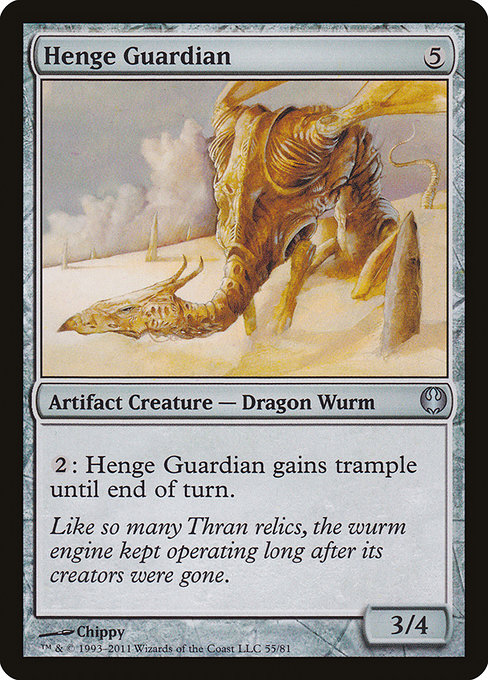
Image courtesy of Scryfall.com
Stone Circles, Thran Tech, and the Henge Guardian
In Magic: The Gathering’s sprawling multiverse, some guardians are forged not from flesh but from the stubborn craft of ancient engineers. Henge Guardian stands as a prime example: a colorless artifact creature—specifically a Dragon Wurm hybrid—imbued with the quiet, persistent will of Thran design. Released as part of the Duel Decks: Knights vs. Dragons lineup in 2011, this uncommon sentinel cost five mana for a respectable 3/4 body. It isn’t flashy in the way of dragon fire or legendary heroes, but it carries a narrative heft that stirs the imagination of lore junkies and power-game enthusiasts alike 🧙♂️🔥.
Rising from the stone circles—those enigmatic rings that anchor power in a landscape thick with myth—Henge Guardian embodies the idea that ancient mechanisms can outlive their creators. The flavor text alludes to the Thran obsession with enduring engines: “Like so many Thran relics, the wurm engine kept operating long after its creators were gone.” This isn’t just poem; it’s a window into MTG lore where relics, runes, and rings persist long after civilizations fade, continuing to press their influence on the world around them. The card’s silhouette—a dragon-wyrm hybrid that looks almost machine-made—fits perfectly with the motif of stone circles as power conduits, channels where stone and sorcery meet in a gauntlet of keystones and gears 💎⚔️🎲.
What it does on the battlefield—and why it matters
At first glance, Henge Guardian is a straightforward, colorless beater: a 5-mana 3/4 artifact creature. The real trick hides in its activated ability: “{2}: This creature gains trample until end of turn.” That small burst of power can swing battles in crowded game states where blockers abound. In the right deck, that two-mana investment turns a modest attack into a legitimate threat, pushing through for damage or forcing trades that tilt the advantage in your favor 🧙♂️.
Because it’s colorless, Henge Guardian slots easily into any colorless or artifact-heavy strategy. In casual and constructed formats where Knights, Dragons, or broader artifact themes roam, it serves as a sturdy beater that can surprise an opponent with trample at a critical moment. The card’s lack of color also invites a wide constellation of support: equipment, ramp artifacts, and auras that can help accelerate the flow of wheels and gears, turning a late-game stalemate into a decisive strike. The subtlety here is how a single activated ability can flex your combat math—thick enough to demand a double take but not so flashy that your plan collapses without it 🔥.
“Like so many Thran relics, the wurm engine kept operating long after its creators were gone.”
The lore and the design converge on a single theme: endurance. Henge Guardian isn’t about a legendary spark or a volcanic blast; it’s about the quiet stubbornness of invention, the rings turning beneath a sky lit by dragon flame, powering through the ages with the patient certainty of a machine that won’t quit. In terms of metagame flavor, that means a defensive cornerstone in some artifact or mixed-color builds that value late-game staying power, with a little surprise on offense when the guard’s reach is suddenly extended by trample.
Art and design: a relic that looks the part
Chippy’s artwork for Henge Guardian leans into the mechanical majesty of Thran craftsmanship, with a silhouette that feels like a living piece of the ancient engine rather than a mere creature. The juxtaposition of a dragon-wurm form with iron and stone textures evokes the uneasy alliance between magic and metallurgy, a hallmark of Thran-era relics. The contrast—organic scale and cog-laden metal—makes the Guardian pop on the table and in the memory, which is exactly the kind of design that MTG art collectors relish 🎨.
Meticulous balance underlines the card’s rarity and reprint status. As an uncommon from a Duel Deck, it’s accessible for casual play and EDH crew alike, not a high-risk treasure hunt but a dependable centerpiece for colorless shards or artifact-synergy decks. The card’s price tag—modest by modern standards—reflects its role more as a thematic cornerstone than a chase mythic, with the flavor and history doing much of the heavy lifting for the storytelling value 🧙♂️💎.
Strategy and deck-building notes
- Maximize the value of the activated ability by pairing Henge Guardian with doubling effects or mana acceleration, so you can push multiple turns of trample damage in a single swing.
- In artifacts-heavy decks, this guardian becomes a reliable late-game component that scales with your board presence, especially when you’ve curved into it from safe ramp or from a steady artifact engine.
- In knights vs. dragons contexts, Henge Guardian can feel thematically appropriate as a stalwart sentinel guarding the line between stone circles and sky-fire, a reminder that ancient tech can outlast even dragon fire.
- Because it’s colorless, it fits into a broad spectrum of decks—from Commander builds to vintage-inspired artifact counts—without forcing a color shift.
- Keep in mind its power tier: a strong value engine that excels when supported by other non-creature wrath-proof or protection-enabling effects—your trampling surprise becomes less obvious and more devastating.
More from our network
- https://crypto-acolytes.xyz/blog/post/shiba-inu-vs-floki-inu-which-meme-coin-wins/
- https://blog.digital-vault.xyz/blog/post/top-xu-ifit-osteoharmonist-jokes-and-nicknames-for-mtg/
- https://blog.digital-vault.xyz/blog/post/how-to-analyze-churn-and-payment-data-effectively/
- https://blog.digital-vault.xyz/blog/post/denethor-ruling-steward-evolving-middle-earth-storylines/
- https://blog.digital-vault.xyz/blog/post/gravebreaker-lamia-framing-and-perspective-in-mtg-card-art/
Whether you’re tracing the lineage of Thran tech or chasing that perfect side quest in your next Commander game, Henge Guardian offers a patient, reliable thread through the tapestry of MTG lore. Its stone-ring mystique makes it a conversation piece at the table—proof that not all legends are about explosions; some are about endurance, craftsmanship, and the quiet power of a well-timed trampling swing 🧙♂️⚔️💎.